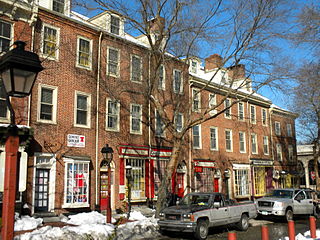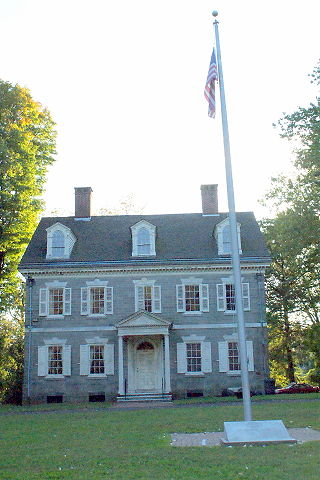History
The Philadelphia Society for the Preservation of Landmarks has played a significant role in the historic preservation movement in Philadelphia by restoring, furnishing, and presenting to the public its distinguished house museums.
In 1931, roused by the news that the historic Powel House was to be demolished in six weeks, Frances Anne Wister and Sophia Cadwalader, and a group of strong supporters, including famous names like Biddle, Barnes, Curtis, and Lippincott, founded Landmarks to save the house. The newly formed Landmarks was successful despite the Great Depression of the time and within another ten years had acquired Grumblethorpe in Germantown.
In the late 1960s, Ambassador and Mrs. Walter Annenberg restored Hill-Physick-Keith House, and then donated the house to Landmarks.
In 1981, Landmarks entered into an agreement with Easttown Township, Pennsylvania to administer historic Waynesborough.
Landmarks attempts to carry on the vision of Wister by managing the four house museums and bringing thousands of visitors and schoolchildren each year to learn about Philadelphia's history.
Landmarks has served as the sponsor in the Philadelphia region for the Road Scholar program, formerly known as Elderhostel. On average, Landmarks Road Scholar Program attracts over 2,000 visitors annually to the Philadelphia region to enjoy its many historical and cultural resources. Landmarks Road Scholar ranks 20th out of a total of 638 sponsors around the world.
Landmarks is a major supporter of the Philadelphia Orchestra, Philadelphia Museum of Art, Philadelphia Flower Show, the Barnes Foundation, and other organizations through its purchase of admission tickets to these fine organizations.
Landmarks Road Scholar accounts for over $500,000 in purchases of hotel rooms and services throughout the Philadelphia region.

Germantown is an area in Northwest Philadelphia, Pennsylvania. Founded by Palatine, Quaker, and Mennonite families in 1683 as an independent borough, it was absorbed into Philadelphia in 1854. The area, which is about six miles northwest from the city center, now consists of two neighborhoods: 'Germantown' and 'East Germantown'.

Society Hill is a historic neighborhood in Center City Philadelphia, Pennsylvania, United States, with a population of 6,215 as of the 2010 United States Census. Settled in the early 1680s, Society Hill is one of the oldest residential neighborhoods in Philadelphia. After urban decay developed between the late 19th and early 20th centuries, an urban renewal program began in the 1950s, restoring the area and its many historic buildings. Society Hill has since become one of the most expensive neighborhoods with the highest average income and second-highest real estate values in Philadelphia. Society Hill's historic colonial architecture, along with planning and restoration efforts, led the American Planning Association to designate it, in 2008, as one of the great American neighborhoods and a good example of sustainable urban living.

The Powel House is a historic house museum located at 244 South 3rd Street, between Willings Alley and Spruce Street, in the Society Hill neighborhood of Philadelphia, Pennsylvania. Built in 1765 in the Georgian style, and embellished by second owner Samuel Powel (1738–1793), it has been called "the finest Georgian row house in the city." As with other houses of this type, the exterior facade is understated and simple, but the interior was elaborately appointed.

Samuel Powel was a colonial and post-revolutionary mayor of Philadelphia, Pennsylvania. Since Philadelphia's mayoral office had been abolished early in the revolutionary period, Powel was the last colonial mayor of the city and the first to serve after the United States gained independence from Great Britain.
The Brandywine Battlefield Historic Site is a National Historical Landmark. The historic park is owned and operated by the Pennsylvania Historical and Museum Commission, on 52 acres (210,000 m2), near Chadds Ford, Delaware County, Pennsylvania in the United States.

Graeme Park is an historic site and National Historic Landmark at 859 County Line Road in Horsham, Pennsylvania, United States. It is owned by the Pennsylvania Historical and Museum Commission and operated by the non-profit group, The Friends of Graeme Park. It is the only surviving residence of a colonial-era Pennsylvania governor.

The Fisher Fine Arts Library was the primary library of the University of Pennsylvania in Philadelphia from 1891 to 1962. The red sandstone, brick-and-terra-cotta Venetian Gothic giant, part fortress and part cathedral, was designed by Philadelphia architect Frank Furness (1839–1912).

Grumblethorpe was the home of the Wister family in the present-day Germantown section of Philadelphia, who lived there for over 160 years. It was built in 1744 as a summer residence, but it became the family's year-round residence in 1793. It is a museum, part of the Colonial Germantown Historic District.

The Henry Antes House is a historic house museum in Upper Frederick Township Montgomery County, Pennsylvania. Built in 1736 by Henry Antes, it is a particularly high-quality example of a Moravian settlement house, with intact original interior finishes. It was designated a National Historic Landmark in 1992, and is now operated as a museum by Goschenhoppen Historians, a local preservation group.

Upsala is a historic mansion in Mount Airy, Philadelphia, Pennsylvania, United States. Considered one of the finest extant examples of Federal architecture, the mansion is a contributing property of the Colonial Germantown Historic District and is listed on the National Register of Historic Places and the Philadelphia Register of Historic Places.

Waynesborough, also known as the Gen. Anthony Wayne House, is a historic house museum at 2049 Waynesborough Road in Easttown Township, Chester County, Pennsylvania. Built in 1724 and repeatedly enlarged, it was for many years the home of American Revolutionary War general Anthony Wayne (1745–1796). A National Historic Landmark, it is now a museum operated by the Philadelphia Society for the Preservation of Landmarks, offering tours and event rentals.

The Hill–Physick–Keith House, also known as the Hill–Keith–Physick House, the Hill–Physick House, or simply the Physick House, is a historic house museum located at 321 S. 4th Street in the Society Hill neighborhood of Philadelphia, Pennsylvania, USA. Built 1786, it was the home of Philip Syng Physick (1768–1837), who has been called "the father of American surgery". The house was declared a National Historic Landmark in 1976. It is now owned and operated by the Philadelphia Society for the Preservation of Landmarks as a house museum.

The Edgar Allan Poe Cottage is the former home of American writer Edgar Allan Poe. It is located on Kingsbridge Road and the Grand Concourse in the Fordham neighborhood of the Bronx, New York, a short distance from its original location, and is now in the northern part of Poe Park.

Belfield, also known as the Charles Willson Peale House, was the home of Charles Willson Peale from 1810 to 1826, and was declared a National Historic Landmark in 1965. The Belfield Estate was a 104-acre (42 ha) area of land in the Logan section of Philadelphia, Pennsylvania, United States, much of which is now a part of La Salle University’s campus.

Herman Louis Duhring Jr. was an American architect from Philadelphia, Pennsylvania. He designed several buildings that are listed on the U.S. National Register of Historic Places.

Hamnett Historic District is a historic district in Wilkinsburg, Pennsylvania. Bordered roughly by Rebecca Avenue, the rear property lines on the east side of Center Street, Sewer Way, and Lytle Way, it encompasses 77 buildings and 114 acres.

Lindenshade(Wallingford, Pennsylvania), was the Wallingford country house and farm of Shakespearean scholar Horace Howard Furness (1833–1912) and family. The house's design is attributed to his brother, architect Frank Furness. It was expanded numerous times, and demolished in 1940. Two other buildings from the property survive. The Helen Kate Furness Library, a memorial to HHF's wife, was built at the west end of the property in 1916.

Walter Rogers Furness Cottage (1890-1891) – also known as the "Old Infirmary" or the "Jekyll Island Infirmary" – is a Shingle Style building on Jekyll Island, in Glynn County, Georgia.

Elizabeth Willing Powel was an American socialite and a prominent member of the Philadelphia upper class of the late 18th and early 19th centuries. The daughter, later sister and then wife of mayors of Philadelphia, she was a salonnière who hosted frequent gatherings that became a staple of political life in the city. During the First Continental Congress in 1774, Powel opened her home to the delegates and their families, hosting dinner parties and other events. After the American Revolutionary War, she again took her place among the most prominent Philadelphian socialites, establishing a salon of the Republican Court of leading intellectuals and political figures.

















